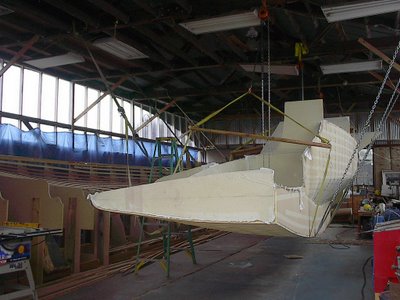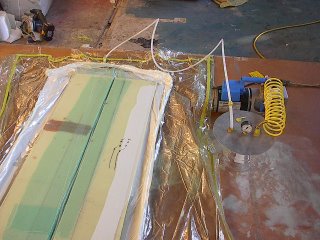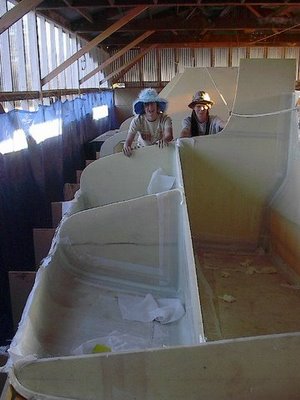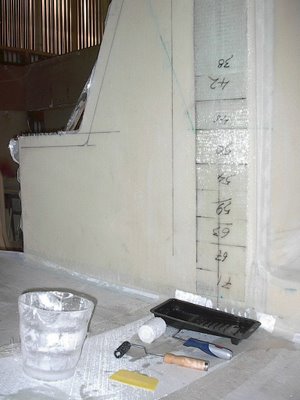
12.30.2006
High density keel strip
12.27.2006
starboard inner hull foam

I found it quicker and easier to thermoform and fit ten inch wide planks and temporarily tack them in place with 2in. x 2in.x1/4in. squares here and there with one sheet rock screw. Once I had ten or so planks formed and ready to edge glue, I numbered them, with a sharpy pen then switched over to the gluing process.
This seemed to go quicker than forming, fitting and gluing one plank at a time.
12.19.2006
Starboard side inner hull takes shape

I'm also using temporary 2in. x 2in. x 1/4in. plywood squares with one sheet rock screw in the middle to hold the foam against the stringers until I screw the foam in from the outside.
When I'm ready to fare the foam, I'll remove them and go at the whole deal with a variety of sanders. After that, I'll lay the 24 oz. triaxial glass.
12.08.2006
Air powered glue gun

http://www.systemthree.com/p_st_gelmagic.asp
Although this product is also available packaged into caulking tubes, I wasn't pleased with the value given that most of the tube is empty space used for the two to one mixing. The guys at Fiberglass supply loaned me a phnumatic glue gun that allows me to bulk load tubes with the product and despense it through mixing tips onto the edges of my corecell strips. It beats mixing the gue up in cups and spreading it on with a butter knife.
The foaming polyurethane glue is much easier to use but I wasn't convienced that it was stronger than the foam itself so I will have to pay the penalty of difficult sanding to come.
foam saver
 After completely ruining a $40.00 plank of nice 3/4 in core cell foam by leaving it in my oven too long. I decided to make a timer that shuts off my oven automaticly. I'm toasting my foam with ten 250W heat lamp bulbs so I needed a heavy duty switch..... The cooking timer triggers the coil that pulls an internal steel tube that pulls a rod that throws the switch that kills the power to the outlet that my oven is plugged into. The wire rail to the left de-energizes the coil once the main switch is thrown........the cooking timer set me back $1.97 and I scrounged the other stuff and spent twenty minutes building this very crude but functional relay.
After completely ruining a $40.00 plank of nice 3/4 in core cell foam by leaving it in my oven too long. I decided to make a timer that shuts off my oven automaticly. I'm toasting my foam with ten 250W heat lamp bulbs so I needed a heavy duty switch..... The cooking timer triggers the coil that pulls an internal steel tube that pulls a rod that throws the switch that kills the power to the outlet that my oven is plugged into. The wire rail to the left de-energizes the coil once the main switch is thrown........the cooking timer set me back $1.97 and I scrounged the other stuff and spent twenty minutes building this very crude but functional relay.
12.03.2006
Starboard side inner hull
 A small pirate came into the shop eating a microwave burrito and asked me when the boat will be ready to sail.
A small pirate came into the shop eating a microwave burrito and asked me when the boat will be ready to sail.
The corecell foam planks are being tacked into place and edge glued using system three gel Magic thixotropic epoxy adhesive. When Ifinish forming the foam, I'll screw all the foam onto the mold from the back side and then romove all the tabs. After that, I'll fair the inside foam and then lay the 24 oz triaxial glass and epoxy as shown before.
11.03.2006
eazy bake oven
I spent a little time building an easy bake oven for my foam strips.....three sheets of surplus foam, ten lamp bases, some heat lamps and if you look real close; lower left hand corner, you can see a BBQ rotissary that I got for $1.00 at a garage sale. I made a crank arm from a screen door frame and attached it to a rack that I mounted on two drawer slides. ........I drape some clear vinyl over the ends like a warehouse door and this allows me to toast my core-cell stips so that they bend real nice into the mold.
........I drape some clear vinyl over the ends like a warehouse door and this allows me to toast my core-cell stips so that they bend real nice into the mold. 
10.26.2006
10.24.2006
floating in mid air
 My friend Cory and I climbed into the rafters to position various lifting devices to allow the port side hull to be moved off the mold and onto the other side of the shop......Next, I'll roll this thing over and spend a few days smoothing and shaping it like a 44 ft. long surfboard in preparation for glassing the outside with 32 oz./ ft.^2 Triaxial glass and epoxy.
My friend Cory and I climbed into the rafters to position various lifting devices to allow the port side hull to be moved off the mold and onto the other side of the shop......Next, I'll roll this thing over and spend a few days smoothing and shaping it like a 44 ft. long surfboard in preparation for glassing the outside with 32 oz./ ft.^2 Triaxial glass and epoxy. 
10.20.2006
imagination
lifting the port side hull
10.08.2006
2000 screws
 With all the bulkheads in place, the next step is to remove all the screws that I put in place to hold the foam snug against the mold stringers.
With all the bulkheads in place, the next step is to remove all the screws that I put in place to hold the foam snug against the mold stringers.
Notice the strips of plastic sheeting under each glue joint of the vertical planks. This should prevent any excess glue from preventing the hull from releasing from the mold.
Once all the screws are out, I'll slip a few straps under the hull and lift her off. 
9.30.2006
bow bulkhead
9.29.2006
Port side bow floor
9.28.2006
port side Bow floor stringer
9.27.2006
electric scissors???????
 It may seem sort of silly but these electric scissors (http://www.esmfg.com/electric_cordless_cutter.htm ) are nice for cutting all types of glass, carbon, kevlar, peel-ply and just about anything else. Only problem is that they bring on post traumatic stress syndrome resulting from that time when the electric hair trimmers put an end to that cool hair style I had going as a kid.
It may seem sort of silly but these electric scissors (http://www.esmfg.com/electric_cordless_cutter.htm ) are nice for cutting all types of glass, carbon, kevlar, peel-ply and just about anything else. Only problem is that they bring on post traumatic stress syndrome resulting from that time when the electric hair trimmers put an end to that cool hair style I had going as a kid. 
port side aft bulkhead in place
 Here's a shot taken from the rafters of the shop. I'm hanging on by one hand from a roof truss and trying to take this picture with my other.
Here's a shot taken from the rafters of the shop. I'm hanging on by one hand from a roof truss and trying to take this picture with my other.
The aft bulkhead is double taped in place on both sides over the 9 layers of Unidirectional and triaxial glass I installed yesterday. Again, I'm in the habbit of laying peel ply over all my joints because it makes such a nice smooth finish. 
9.26.2006
keeping epoxy away
It has taken me a while to come up with a good method of keeping myself epoxy free. First I put on a full Tyvex jump suit, apply a barrier cream on my hands then playtex gloves, a latex glove over that so that if I have to cut peel ply or handle my scissors, I can just peel off the latex use a tool without getting it all sticky then put on another latex if I need to continue glassing......seems to work OK. 

aft bulkhead location prep
The aft bulkhead gets mounted on ten tapered layers of Unidirectional glass. I cut them to length then wet them in individually to insure good saturation. Over this goes a 16 in. wide girth strip of 24oz./ft^2 triaxial glass. ( Farrier says that when using epoxy, it's ok to use 9 layers ) Wow....that saves me a few ounces. Maybe I could take an extra bottle of beer on board.

9.25.2006
cabin bulkhead install
Installed the two 32in. uni directional strips, layed the 16 in. wide triaxial girth strip, bedded corecell foam bulkhead strips along bulkhead join line, gooped the whole mess with epoxy/micro/aero putty and installed the cabin bulkhead then double taped it in place and covered everything in peel ply.......all after work and before midnight...... 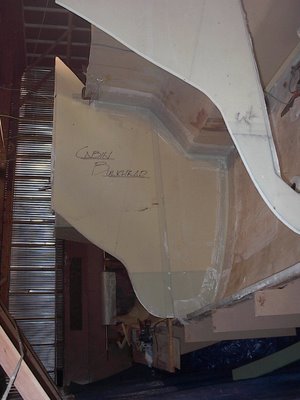

9.24.2006
bulkhead scribe tool
Here's a simple scribe tool that I use to mark the final fit demension of the bulkheads. I place the bulkhead where it's supposed to go; then I run this scribe and mark the bulkhead on both sides by keeping the block up against the inside of the hull. The small block of 3/4 in foam is the same thickness of the foam bulkhead mounting strips so once the bulkhead is cut along this line, the bulkhead will fit perfectly against the mounting strips.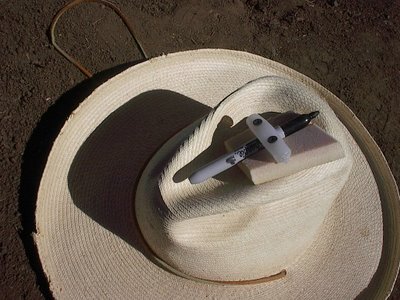

port side mast bulkhead installed
sugar bugs
When you see lots of sugar bugs in the air it's best to use a dust mask. I's no fun when your lungs itch........ a white suit, a good hat, a double cartridge dust mask and a really nice Bosch sabre saw can make cutting fiberglass bareable.
I use a carbide grit saber saw blade for trimming the edges of the bulkheads. If you start the cut and hold the blade up against the inside edge of the panel, the blade can be made to follow the edge because the vacuum bag process creates a reinforced edge that helps guide the blade. 

9.23.2006
fitting the forward bulkhead
As suggested in the plans, the bulkheads can be fitted against foam strips rather than just blopping them in with putty ( epoxy / micro / aero ). Farrier says that this is better but takes more time........a farmer was holding his pig up in the air under an apple tree so he could eat. a catamaran builder walked up and said: " that sure is a waste of time". The farmer said: " time dont mean nothin to a pig"...............I think there may be a time when I'm off the coast of Africa in a storm and wishing I had glassed the bulkheads in the best I could have. So thinking that, I don't really have a choice.
Next, I'll show a picture of the finished double glass tape and epoxy bulkhead join detail. 


